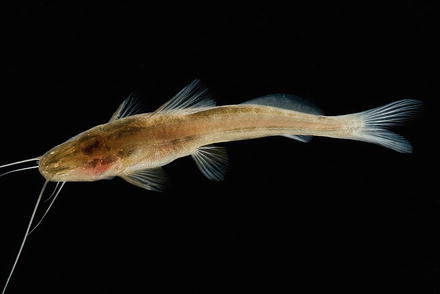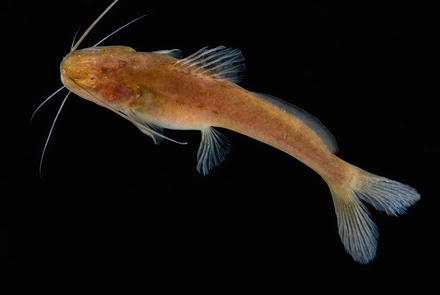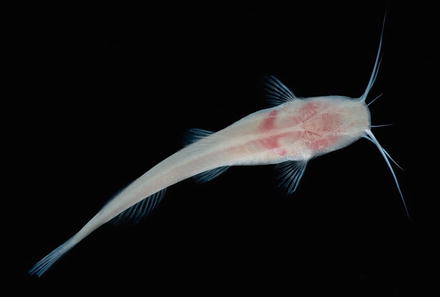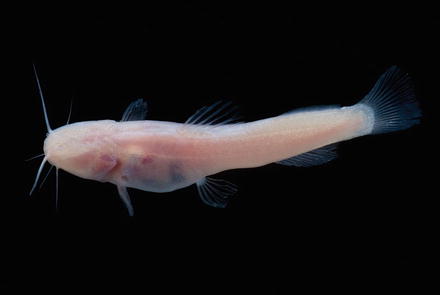Fig. 4.1
White “piaba,” Stygichthys typhlops (Teleostei: Characiformes), troglobitic fish from phreatic waters in Minas Gerais State, eastern Brazil, showing a high degree of specialization to the subterranean life, including fully regressed eyes and melanic pigmentation. Photo: Dante Fenolio
In spite of the abundant studies on the troglobitic tetra characins, mostly concerned with genetic aspects, not much has been done from a chronobiological perspective. In the few published reports of studies performed under constant (free-running) conditions, epigean Astyanax mexicanus fish are compared with their cave relatives A. antrobius (from El Pachon cave, a junior synonym of A. jordani, Proudlove 2010, referred to by later authors as A. mexicanus cave form) and A. jordani sensu stricto (from La Cueva Chica, the type locality, also referred to by later authors as A. mexicanus cave form) fish; the first is completely devoid of eyes, the second has intermediate characteristics of eyes and pigmentation (Erckens and Martin 1982a). As expected for an epigean species, in Astyanax mexicanus free-running activity rhythms were detected under constant darkness. The authors also applied several LD cycles (12:12 h, 6:6 h, 4:4 h, 16:8 h, etc.), all shown to entrain locomotor activity. On the other hand, in the phylogenetically old A. antrobius, although activity was entrained by all applied LDs, the circadian rhythm of total activity disappeared immediately after the transition from LD to DD (no residual oscillations). The activity responses to changing environmental conditions were not as uniformly quick as in A. mexicanus, but the system hardly needed a swing-in time to be synchronized by the imposed LD. The authors concluded that the internal clock of A. antrobius was simplified in relation to its epigean ancestor: the passive system has developed into an extremely passive one, incapable of synchronizing; thus, the circadian oscillator was subject to regression, but it was not completely lost (Erckens and Martin 1982b). Astyanax jordani from La Chica seems to be intermediate also in this aspect, because one or two residual oscillations were observed after a transition from LD (12:12) to DD (Erckens and Weber 1976).
We have studied the temporal pattern of locomotor activity of 11 Brazilian species, the highly specialized characid (Characiformes), Stygichthys typhlops (Fig. 4.1), of uncertain affinities within Tetragonopterinae, and ten siluriforms (catfishes and armored catfishes): the heptapterids Pimelodella kronei (Fig. 4.2), the first discovered and described Brazilian troglobite and to now the most intensively studied; P. spelaea and Rhamdia enfurnada (Fig 4.3) (all Rhamdiini); Rhamdiopsis krugi (Fig. 4.4) (cited as Imparfinis sp. in Trajano & Menna-Barreto 1995 and cave fish from Chapada Diamantina in Trajano et al. 2005), Rhamdiopsis undescribed sp. from Toca do Gonçalo cave, Bahia State (Fig. 4.5) (cited as Taunayia sp. in Trajano and Menna-Barreto 2000) and Rhamdiopsis undescribed sp. from Salitre cave, Minas Gerais State; the trichomycterids Trichomycterus itacarambiensis, T. dali, and T. rubbioli; and the Callichthyidae, Aspidoras cave form (Trajano and Menna-Barreto 1995, 1996, 2000; Trajano et al. 2005, 2009, 2012). Among these, P. spelaea has the least reduced eyes when compared with the epigean congeners—the eye structure is apparently normal, but the size is significantly smaller, followed by A. albater cave form and Rhamdiopsis sp. from Salitre cave. On the other end of the range, S. typhlops (Fig. 4.1), R. krugi (Fig. 4.4), and Rhamdiopsis sp. from Toca do Gonçalo (Fig. 4.5) are the most troglomorphic species, homogeneously devoid of any traces of pigment or visual structures. Rhamdia enfurnada provides a good example of an intermediate evolutionary stage, with a mosaic distribution of character states, illustrating the independence of regression of eyes and melanic pigmentation (Trajano and Bichuette 2010). In Fig. 4.3, we show an individual with intermediate condition of both eyes and melanic pigmentation. P. kronei is so far known from six localities, the largest population being that of its type locality, the Areias de Cima cave. It is a relatively specialized troglobite, with ca. 90 % of the individuals from the Areias de Cima population without externally visible eyes (the remaining ones with vestigial eyes); the melanic pigmentation phenotypes show a normal distribution within this population, consistently with the notion of an independent evolution of these characters.





Fig. 4.2
The blind catfish from Iporanga, Pimelodella kronei (Teleostei: Siluriformes: Heptapteridae), first troglobite discovered and described in Brazil, showing a moderate degree of troglomorphism: partially pigmented individual without externally visible eyes. Photo: Dante Fenolio

Fig. 4.3
Rhamdia enfurnada (Teleostei: Siluriformes: Heptapteridae), troglobitic catfish endemic to a single cave in south Bahia State, northeast Brazil, with a great intrapopulation variability in the degree of reduction of eyes and melanic pigmentation: individual with very reduced but still externally visible eyes and intermediate pigmentation. Photo: Dante Fenolio

Fig. 4.4
Rhamdiopsis krugi (dorsal view) (Teleostei: Siluriformes: Heptapteridae), highly troglomorphic catfish from phreatic waters, found in several caves from central Bahia State, northeast Brazil. Due to the total absence of melanic pigmentation, internal organs, such as the brain, may be seen by transparence. Photo: Dante Fenolio

Fig. 4.5
Another highly specialized Rhamdiopsis catfish (Teleostei: Siluriformes: Heptapteridae; undescribed species), from a phreatic waterbody in a cave from north Bahia State, northeast Brazil. Photo: Dante Fenolio
Those fish species also differ in their habitat. Although, as for the degree of troglomorphism, no taxonomic correlation was observed, the more specialized species are found in the upper phreatic zone connected to the surface through caves (R. krugi and Rhamdiopsis sp. from Toca do Gonçalo) or artificial wells (S. typhlops), typically a very stable habitat. The population of T. dali inhabits a submerged cave, apparently buffered against environmental fluctuations, but its morphology indicates that it was not isolated in the subterranean habitat for as long as the former three. On the other hand, species such as P. kronei, Aspidoras albater cave form, Rhamdiopsis sp. from Salitre cave, Trichomycterus itacarambiensis, and R. enfurnada inhabit at base-level streams, subject to periodic changes in water level, which may be very drastic in very seasonal areas, as is the case for the latter two.
For comparative studies, the ideal situation is to compare the troglobites to their epigean sister species and then to at least one close outgroup, but this requires phylogenies for the taxa of interest, which are not available for most of the studied groups. Moreover, it is necessary to collect and maintain both epigean and troglobitic specimens. We were able to fulfill such conditions for the blind catfish from Iporanga, P. kronei, with its epigean putative sister species, P. transitoria (Trajano and Menna-Barreto 2005; Duarte and Menna-Barret unpubl. data on feeding rhythms—see below), which forms troglophilic populations in the Alto Ribeira karst area, São Paulo State, one of which is syntopic with the troglobitic species in the Areias de Cima cave (such syntopy would be due to secondary dispersion of P. transitoria into the cave). We also compared Rhamdiopsis sp. from Toca do Gonçalo to the epigean Taunayia bifasciata (Trajano and Menna-Barreto 2000). The epigean catfish P. transitoria (seven specimens monitored) and Taunayia bifasciata (two specimens) exhibited strong, significant free-running circadian components of locomotor activity. In contrast, a great deal of variation regarding the expression of the free-running components of activity was observed in the studied blind catfish (six specimens from Areias cave, three from Bombas resurgence), with two Areias individuals showing no significant circadian rhythms. Rhamdiopsis sp. from Toca do Gonçalo presented much weaker periodicities: only one out of five studied specimens exhibited a significant circadian rhythm in surface activity, but not in bottom and total activity, and two were completely arrhythmic, not even showing ultradian rhythms. It is noteworthy that differences in temporal patterns of surface and bottom activity were also observed on Astyanax fish. As expected for siluriforms, generally nocturnal and quimioriented, thus preadapted to the subterranean life, peaks of activity occurred during the dark phases (Trajano and Menna-Barreto 2000: Fig. 4.1).
Individual variability regarding the presence versus absence of significant circadian components of locomotor activity was observed in all studied species, with a loose correlation with the degree of troglomorphism. Among the three most specialized species, Stygichthys typhlops has proceeded further towards the regression of the mechanism of time control (Trajano et al. 2009).
This individual variability in the free-running circadian rhythmicity may be due to the following factors: (1) a relatively short time in isolation in the subterranean habitat, insufficiently long to genetically stabilize changes in the timing systems throughout the populations, and (2) time signals being present that act as zeitgebers, such as temperature cycles for P. kronei (Trajano and Menna-Barreto 1995), R. enfurnada, and Rhamdiopsis sp. from Salitre cave (Trajano et al. 2009) or LD cycles for R. krugi from Poço Encantado cave (Trajano et al. 2005).
Several species were also studied under LD cycles, 12:12 h (Trajano and Menna-Barreto 2000; Trajano et al. 2012). In the highly troglomorphic Rhamdiopsis sp. from Toca do Gonçalo and R. krugi, activity was entrained by these cycles, but no residual oscillations were observed, indicating a possible masking effect. Such entrainment was not observed for S. typhlops, which represents a further step towards the loss of temporal mechanisms.
The comparison between the temporal patterns of locomotor activity between troglobitic fish and their epigean close relatives (Astyanax antrobius × A. jordani × A. mexicanus; Pimelodella kronei × P. transitoria; Rhamdiopsis sp. from Toca do Gonçalo × T. bifasciata), studied under the same protocols, provides good evidence for the hypothesis of evolutionary regression of circadian timing system in troglobitic species, either affecting the oscillator(s) itself (themselves) or due to an uncoupling between the oscillators affecting the circadian component of locomotor activity. Regression of the retina and, at least for some of the studied species, possibly also of the photoreceptor of the pineal organ may be involved in the disorganization of the circadian system verified in several troglobitic species. These results favor the notion of external ecological factors as the main factors stabilizing the selection for circadian rhythms. The progressive loss of circadian locomotor rhythmicity in different troglobitic fishes in parallel (but not necessarily correlated) with other regressive characters indicates that similar processes may be involved in such regression.
Stay updated, free articles. Join our Telegram channel

Full access? Get Clinical Tree


